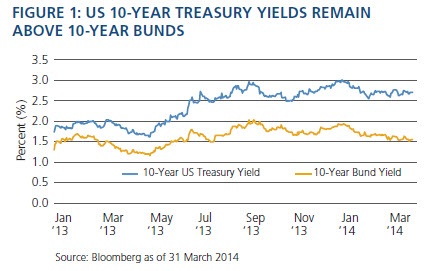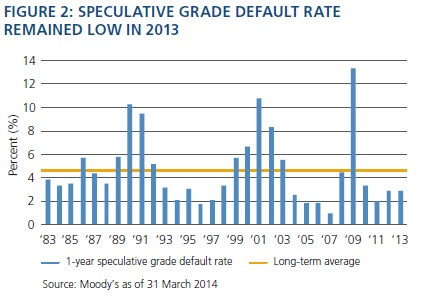Investors set their sights on Europe's rising stars
As the outlook for Europe and other major developed economies continues to improve, the environment remains supportive for risk assets. Within fixed income, investors and PIMCO portfolios are emphasising credit spreads over duration.
Further, with conditions in the eurozone returning, albeit slowly, to health, European credit is increasingly attracting interest from global investors. Indeed, Europe’s ‘not too hot, not too cold’ environment can be a sweet spot for credit investors who are facing a faster interest rate rise and corporate releveraging cycle in the US and the UK than in continental Europe.
Given supportive fundamentals and strong technicals in Europe, credit valuations are broadly fair. However, value exists for investors able to move off traditional index beta and focus on specific credit sectors and bottom-up security selection. At PIMCO, for example, we favour select bank capital securities, corporate hybrids and ‘rising stars’ -- companies with improving credit profiles whose ratings are candidates to be upgraded from high yield to investment grade -- for our European credit exposure.
European duration: a safer bet
European economies, core and peripheries alike, continue to improve. Following PIMCO’s Cyclical Forum in March this year, at which we specify our six to 12-month forecast for the level of economic growth and inflation in key regions, we forecast that Europe will grow
at 1-1.5 per cent over the coming 12 months, compared to just 0.5 per cent last year. Although the recovery is moving in the right direction, eurozone growth remains significantly below the US and the UK, which are expected to grow at 2.5-3 per cent.
While both the US Federal Reserve and the Bank of England are contemplating the beginning of a rate hiking cycle in 2015, the European Central Bank is moving in the opposite direction.
With recent inflation reading below 1 per cent, the ECB is increasingly concerned about inflation staying too low for too long, a trend that could de-anchor long-term inflation expectations in Europe. More importantly, the ECB’s recent statement on April 3 introduced new language, stating that the ECB Governing Council is now “unanimous in its commitment to using also unconventional instruments within its mandate to cope effectively with risks of a too prolonged period of low inflation”.
Whichever conventional and unconventional instruments the ECB decides to deploy, European duration should be safer compared to the US and UK (see Figure 1), and the central bank’s easing bias is supportive for European risk assets.

Supportive fundamentals
The improving growth outlook is also supportive for corporate revenue growth and overall balance sheet health. Over the past few years, corporates have taken advantage of the market liquidity provided by global central banks’ accommodative monetary policies and historically low yields to refinance their balance sheets with long-term debt and lower interest expenses. Corporate default rates are expected to remain at historically low levels given the positive growth environment and lack of refinancing need (see Figure 2). According to recent research by rating agency Moody’s, the expected default rate is forecasted to come in at around 2.2 per cent in 2014 (as of March 2014).

Emboldened by stronger growth, shareholders are putting increasing pressure on companies to releverage their balance sheets to finance acquisitions, and increase dividends and share buy-backs.
While still at historically average leverage levels, the current releveraging trend is more pronounced in the US, where expected growth and corporate confidence are higher. European corporates, on the other hand, are still recovering from the region’s sovereign debt crisis. Due to a more subdued growth environment, we believe European corporates are lagging around 12-18 months behind the US in the releveraging cycle.
Strong technicals
Benefitting from strong equity performance and a bump in interest rates in 2013, pension funds’ funding gap has mostly closed. This allows pension funds to de-risk, reducing their equity exposure in favour of increasing their fixed income exposure, especially in the context of an ageing population and increasing pension payouts.
Similarly, bank and insurance companies, encouraged by their regulators, are reducing their allocations to equities in favour of investment grade credit, which attracts less regulatory capital. On the supply side, the primary market is reaching record levels in the US. Meanwhile, Europe’s financial sector continues to deleverage, contributing to a still-negative net supply of European investment grade credit (see Figure 3).

Given the strong fundamental and technical background, valuations in investment grade credit seem fair and likely to stay at the same level or potentially tighten over the next 12 months.
Finding value in Europe’s credit market
Bank capital securities
While corporates are releveraging, financials are still deleveraging, encouraged by regulators on both sides of the Atlantic to raise ever more capital, shrink their balance sheets, improve their liquidity and shut down risky businesses.
This new regulatory environment may not be friendly for the banks’ shareholders, but it is making banks safer, reducing default risk and bank debt supply. We remain overweight financials and prefer the lower part of the capital structure. This is where we expect further spread compression versus senior bank debt, which will become bail-in able from 2016 onwards. Contingent convertible securities (CoCos) issued by European banks yield 4-6 per cent (based on BofA Merrill Lynch data from March 2014) and continue to represent an attractive investment opportunity.
Corporate hybrids: a growing European opportunity
We also find value in the relatively new corporate hybrid bond market. Corporate hybrids are subordinated perpetual bonds callable after five to 10 years. Although such securities cannot be converted into equity, rating agencies treat them as 50% equity until the first call date (the first date on which the issuer may exercise its right to redeem the bond before maturity). Corporate issuers are thus taking advantage of low yields to issue subordinated debt instead of diluting shareholder value.
For investors, it is an opportunity to invest in high quality corporate credit that presents a low default risk but invests lower in the capital structure where recovery would be lower and pick up three times the senior credit spread. We favour those instruments issued by high-quality, stable companies -- typically single-A rated utility companies -- where the individual hybrid bond is BBB rated and carries a 4-5 per cent yield for a 3-5 year duration (BofA Merrill Lynch as of March 2014).
Identifying ‘rising stars’
Structurally, rising stars tend to offer the best risk adjusted return potential. At PIMCO, we focus on identifying those rising stars and, conversely, avoiding ‘’falling angels’ -- companies being downgraded to high yield -- rather than replicating an index that rewards the most indebted companies with the highest index weight.
© Pacific Investment Management Company LLC. Republished with permission. All rights reserved.
We find a number of rising stars in the European credit market, especially in the cyclical sectors that are benefitting from the improved economic environment, such as the automotive and building materials sectors.
The current environment of improving growth and disappointing inflation keeps central banks engaged and is supportive for risk assets. The recent ECB comments pointing to further easing bias make European assets relatively attractive. We believe European credit offers compelling opportunities, especially in sectors with deleveraging fundamentals, positive technicals and attractive valuations with the potential for further spread compression.
















